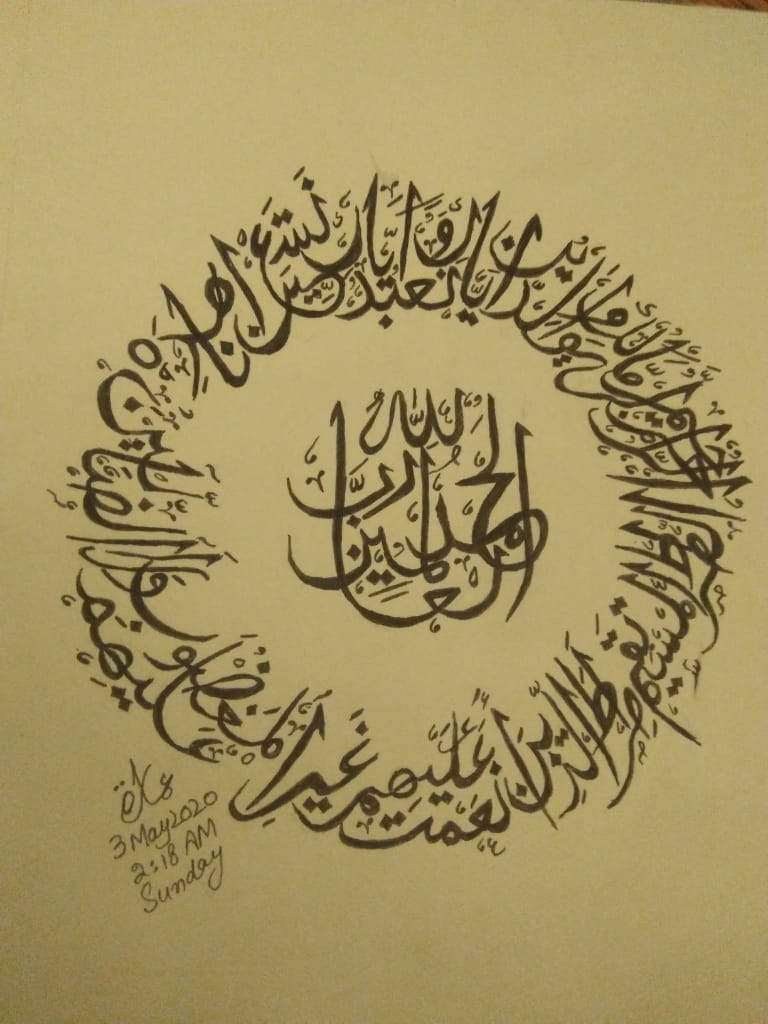Arabic calligraphy was originally a tool for communication, but with time, it began to be used in architecture, decoration and coin design. Its evolution into these major roles was a reflection of the early Muslims’ need to avoid, as their beliefs required, figures and pictorials that were used as idols before Islam was established in the Arabian Peninsula.
While the Arabic tribes preferred to memorize texts and poetry, the first Muslims tried to document their holy book (Qur’an Kareem) using the scripts that we’ll look at in this article. In order to understand how these scripts developed into the beautiful and complex shapes we know today, we have to understand the history of Arabic calligraphy.
_
Surah Al Fatiha:
Surah al Fatiha is a cure for physical and also spiritual ailments. Without this Surah, even the daily prayers are incomplete. It is indeed a great treasure that has been given to us by Allah (S.w.T.) through the Holy Prophet (S) and no previous prophet has been given anything like it. This Surah is also known as ‘Ummul Kitab’ and ‘Sab’a mathani’.
_
Importance of Surah Al Fatiha:
There are seven verses in this Surah (chapter) and it is said that this Surah is both ‘makki’ and ‘madani’ ie. it was revealed in both Makkah and Madinah.
In the commentary of Majma’ul Bayan it is narrated that the Holy Prophet (S) said that whoever recites this Surah, he will get the reward for reciting two thirds (2/3) of the whole Qur’an, and will get the reward equivalent to what would be gained by giving charity to all the believing men and women in the world.
One of the companions of the Holy Prophet (S) narrates that he once recited this Surah in the presence of the Holy Prophet (S) and the Prophet said, ‘By Him in whose hand is my soul, a similar revelation to this has not been included in the Taurat (Torah), Injeel (Bible), Zabur (Psalms)or even the Qur’an itself.’
The Holy Prophet (S) once asked Jabir ibn Abdallah Ansari, “Should I teach you a Surah that has no other comparison to it in the whole Qur’an ?” Jabir replied, “Yes, and may my parents be ransom upon you O prophet of Allah.” So the Holy Prophet (S) taught him Surah al-Fatiha. Then the Holy Prophet (S) asked, “Jabir, should I tell you something about this Surah ?” Jabir answered, “Yes, and may my parents be ransom upon you O prophet of Allah.” The Prophet (S) said, “It (Surah al-Fatiha) is a cure for every ailment except death.”
Imam Abu Abdillah Ja’far as-Sadiq (A.S.) has said that whoever cannot be cured by Surah al-Fatiha, then there is no cure for that person. In the same narration it is written that if this Surah is recited 70 times on any part of the body that is paining, the pain will surely go away. In fact, the power of this Surah is so great that it is said that if one were to recite it 70 times over a dead body, you should not become surprised if that body starts moving (ie. comes back to life).
The Surah is really effective to light up the spirit of faith in the heart of a Muslim. Surah Al Fatiha is a powerful prayer between us and our Lord, where we invoke His most beautiful names, attest to His sovereignty, seek His help and guidance and ask Him to shower His blessings upon us.
–
Translation of Surah Al Fatiha:
All praise unto Allah, Lord of all the worlds. The most Affectionate, The Merciful. Master of the Day of Requital. We worship You alone, and beg You alone for help. Guide us in the straight path. The path of those whom You have favoured. Not of those who have earned Your anger and nor of those who have gone astray.
_
Calligraphy benefits:
1) It is Meditative and relaxing.
2) It helps develops fine motor skills and memory retention.
3) We are most creative when we are using our hands.
4) It helps us make sense of our thoughts and promotes critical thinking.
5) It helps us gain confidence as we get better at the skill.


Niceeee